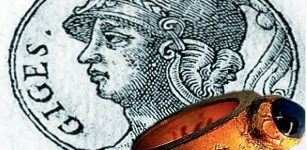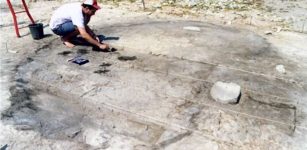Biblical Prophet Jeremiah Whose Prophecies Disappointed People
David Tee - AncientPages.com - Archaeology can do many things. It can unearth buildings, long lost artifacts, and even discover civilizations lost to history. The Hittites are one prime example of the last as their empire was lost for 1800 years. It wasn’t until the 19th century AD that archaeology unearthed that nation.

Jeremiah, as depicted by Michelangelo from the Sistine Chapel ceiling. Image credit: Vatican Museums via Wikipedia
But can archaeology prove someone’s existence? This is a difficult question to answer as even modern people’s existence can be called into question. With lots of legal identification and paperwork in their possession, their existence can be refuted. Let’s see what archaeology can do for the Biblical prophet Jeremiah.
Who Was Prophet Jeremiah?
The meaning of his name is unknown or under heavy debate, but one thing is for sure because of his prophecies, he was known as the weeping prophet. He was called the weeping prophet because he knew what was going to happen and cried tears of sadness. He was also very sad because people didn't want to listen to him.
Jeremiah was born into the priestly family of Hilkiah.
His hometown was Anathoth which gives him a connection to Abiathar, a priest during King Solomon’s reign. Jeremiah never married as he obeyed God’s instruction to avoid marriage due to the upcoming problems Israel was going to endure.
Zephaniah was a prophet who came just before Jeremiah and Habakkuk, Obadiah and Ezekiel were contemporaries at some point in his life. Jeremiah prophetic ministry took place between 626 and 586 BC.
There is no information about his death.
What Did Jeremiah Prophecy?
The prophet was not noted for saying anything good for Israel, Jerusalem or its rulers. Jehoiakim was so incensed at hearing some of the words Jeremiah had written that he cut the scroll up into pieces and burned it in the fire (Jer. 36:21).

Jeremiah on the ruins of Jerusalem. 1844. Source
Jehoiachin and Zedekiah also did not fare well in some of Jeremiah’s prophecies. The prophet made calls for Jerusalem’s and all of Israel’s repentance and return to the laws of God. He also spoke of the upcoming Babylonian captivity. Foreign nations were not left out of his doom and gloom-type prophecies.
Jeremiah did, however, provide a little hope. He did prophecy that the people of Israel and Jerusalem would be restored to their land eventually.
Archaeology Uncovers Evidence Of Prophet Jeremiah
Archaeologists have made some rather startling discoveries over the years. Some pertain to the prophet Jeremiah in an indirect way. One discovery contained 250 bulla or clay seals. A few of these seals had names of people included in the book of Jeremiah.
A bulla is a little clump of clay that has an impression stamped on it. Fire does not destroy bulla but helps preserve them forever.
- Jerucal ben [son of] Shelemiah ben [son of] Shevi- mentioned in Jer. 37:3 and 38:1
- Berekhyahu son of Neriyahu the scribe- he was Baruch, Jeremiah’s scribe and he was mentioned in Jer. 36:1-4
- Elishama' servant of the king- Jer. 36:10-12
- Yerahme'el, son of the king- son of Jehoiakim Jer. 36:26
- Gedalyahu ben Pashur & Yehukual ben Shelemyahu- they sought the death of the prophet & mentioned in Jer. 38
Jeremiah 32 (the thirty-second chapter of the Book of Jeremiah) talks about how a relative came to the prophet to have the latter redeem a field in their hometown. Jeremiah had Baruch place the deeds in two clay jars. Similar jars were unearthed in the area where the 250 bullae were discovered.

Jeremiah Lamenting the Destruction of Jerusalem, Rembrandt van Rijn, c. 1630. Source
Then an inscribed clay tablet was uncovered held in storage at the British Museum, some dating back 5,000 years. On this clay, tablet was a name. It was a name of great importance. Jeremiah wrote that Nebo-Sarsekim was an important officer to Nebuchadnezzar II.
He was also the one charged by Nebuchadnezzar to look after Jeremiah.
Archaeology has illuminated much of the Old Testament. Archaeologists have spent their lives looking for physical evidence to support and prove the biblical record. These discoveries have gone a long way in showing that Jeremiah actually existed.
But they do more than that. They also show the veracity and accuracy of the biblical book. Nebo-Sarsekim may have been an important officer to Nebuchadnezzar II but to history, he was very insignificant.
Since this little unimportant passage has been shown to be correct, what does it say about the book’s author and the major events? It means that Jeremiah was real and was a prophet of God.
Written by – David Tee - AncientPages.com Staff Writer
Copyright © AncientPages.com All rights reserved. This material may not be published, broadcast, rewritten or redistributed in whole or part without the express written permission of AncientPages.com
More From Ancient Pages
-
 Ancient Mysteries Of The Amazon Jungle – Survivors Of The Great Flood Or An Atlantean Race Hidden In The Forest? – Part 2
Ancient Mysteries | May 29, 2018
Ancient Mysteries Of The Amazon Jungle – Survivors Of The Great Flood Or An Atlantean Race Hidden In The Forest? – Part 2
Ancient Mysteries | May 29, 2018 -
 Intriguing Ket People – The Last Nomadic Hunter-Gatherers Of Siberia
Featured Stories | Nov 23, 2023
Intriguing Ket People – The Last Nomadic Hunter-Gatherers Of Siberia
Featured Stories | Nov 23, 2023 -
 Seven Times People Discovered The Americas And How They Got There
Featured Stories | Sep 9, 2022
Seven Times People Discovered The Americas And How They Got There
Featured Stories | Sep 9, 2022 -
 Treasure Of 1,753 Roman Silver Coins Accidentally Discovered In Poland
Archaeology | Apr 1, 2020
Treasure Of 1,753 Roman Silver Coins Accidentally Discovered In Poland
Archaeology | Apr 1, 2020 -
 Oldest Modern Human Genome Identified With The Help Of Neanderthal Ancestry
Archaeology | Apr 14, 2021
Oldest Modern Human Genome Identified With The Help Of Neanderthal Ancestry
Archaeology | Apr 14, 2021 -
 What Can The Fate Of Ancient Cities Teach Us About Surviving Climate Change
Archaeology | Oct 1, 2021
What Can The Fate Of Ancient Cities Teach Us About Surviving Climate Change
Archaeology | Oct 1, 2021 -
 Lost Medieval Kingdom Found In West Sussex, UK
Archaeology | Jul 1, 2024
Lost Medieval Kingdom Found In West Sussex, UK
Archaeology | Jul 1, 2024 -
 Five Rare Bronze Age Axe Heads Found In Polish Forest
Archaeology | Dec 8, 2023
Five Rare Bronze Age Axe Heads Found In Polish Forest
Archaeology | Dec 8, 2023 -
 2,000-Year-Old Knife With Denmark’s Oldest Runes Found On Funen
Artifacts | Jan 22, 2024
2,000-Year-Old Knife With Denmark’s Oldest Runes Found On Funen
Artifacts | Jan 22, 2024 -
 Leprechaun: One Of The Most Famous And Powerful Creatures Of The Irish Faerie Folk
Celtic Mythology | May 8, 2016
Leprechaun: One Of The Most Famous And Powerful Creatures Of The Irish Faerie Folk
Celtic Mythology | May 8, 2016 -
 Nippur – Holy City Of God Enlil And One Of The Oldest Cities Of Sumer
Featured Stories | Jul 24, 2023
Nippur – Holy City Of God Enlil And One Of The Oldest Cities Of Sumer
Featured Stories | Jul 24, 2023 -
 Rare Artifacts Found In Nottingham’s Mysterious Caves On Display For The First Time
Archaeology | Feb 7, 2024
Rare Artifacts Found In Nottingham’s Mysterious Caves On Display For The First Time
Archaeology | Feb 7, 2024 -
 Remains Of Ancient Predators Shed Light On How Humans Did Or Didn’t Find Food
Archaeology | May 2, 2022
Remains Of Ancient Predators Shed Light On How Humans Did Or Didn’t Find Food
Archaeology | May 2, 2022 -
 Magical Ring Of Gyges And Its Power To Be Invisible At Will
Featured Stories | Feb 16, 2023
Magical Ring Of Gyges And Its Power To Be Invisible At Will
Featured Stories | Feb 16, 2023 -
 On This Day In History: Sverre Sigurdsson Became King Of Norway – On June 29, 1194
News | Jun 29, 2016
On This Day In History: Sverre Sigurdsson Became King Of Norway – On June 29, 1194
News | Jun 29, 2016 -
 Mysterious, Well-Preserved Ancient Foreign Mummies Found On Remote Islands In North America
Featured Stories | Jan 5, 2025
Mysterious, Well-Preserved Ancient Foreign Mummies Found On Remote Islands In North America
Featured Stories | Jan 5, 2025 -
 Ancient Mystery Of The American Southwest – Unusual Skeletons And Mummies – Part 2
Ancient Mysteries | Jul 24, 2018
Ancient Mystery Of The American Southwest – Unusual Skeletons And Mummies – Part 2
Ancient Mysteries | Jul 24, 2018 -
 Survivors Of The Latest Ice Age Thrived Near The Sea Of Galilee 23,000 Years Ago
Archaeology | Jan 27, 2022
Survivors Of The Latest Ice Age Thrived Near The Sea Of Galilee 23,000 Years Ago
Archaeology | Jan 27, 2022 -
 Magnificent Trumpington Cross And Highly Unusual Anglo-Saxon ‘Bed Burial’ In Cambridge Offer Unique Insight Into English Christianity
Archaeology | Feb 22, 2018
Magnificent Trumpington Cross And Highly Unusual Anglo-Saxon ‘Bed Burial’ In Cambridge Offer Unique Insight Into English Christianity
Archaeology | Feb 22, 2018 -
 America’s Oldest Tombstone: Jamestown’s Black “Marble” Knight’s Tombstone Was Imported From Belgium
Archaeology | Sep 27, 2024
America’s Oldest Tombstone: Jamestown’s Black “Marble” Knight’s Tombstone Was Imported From Belgium
Archaeology | Sep 27, 2024
